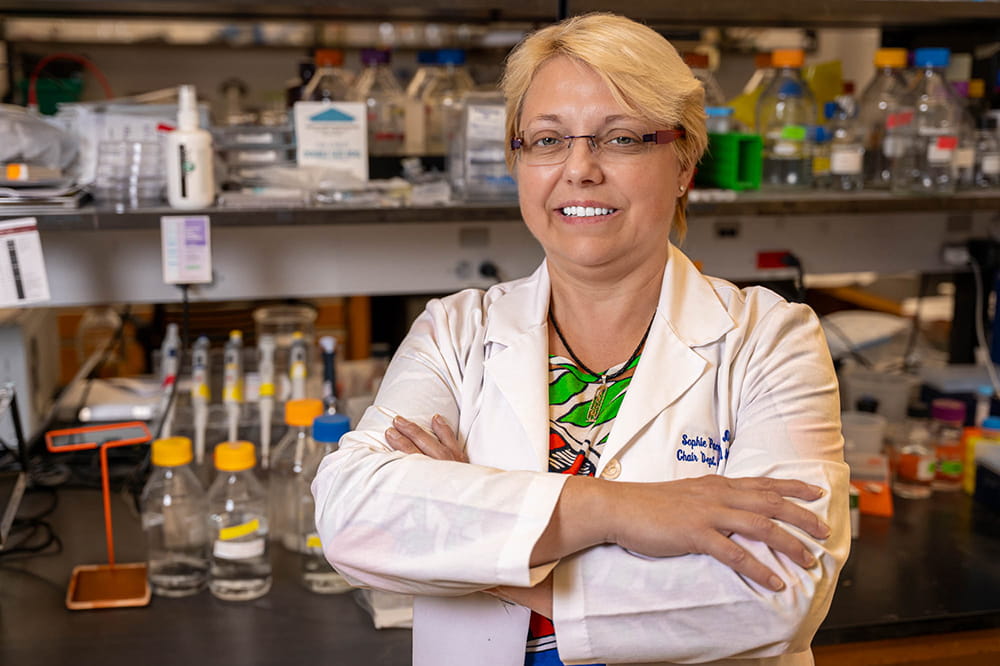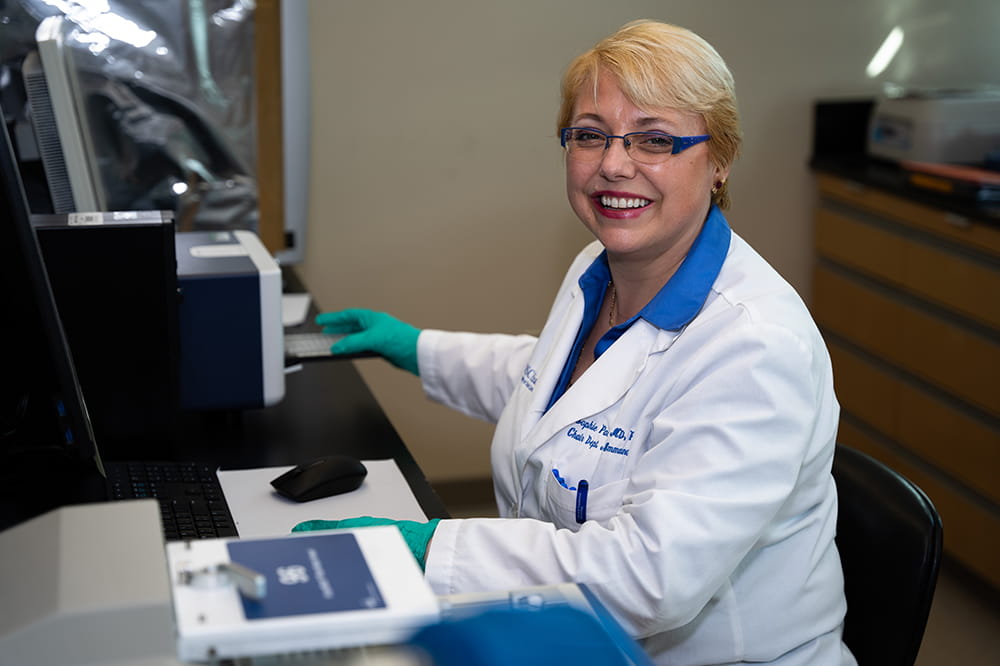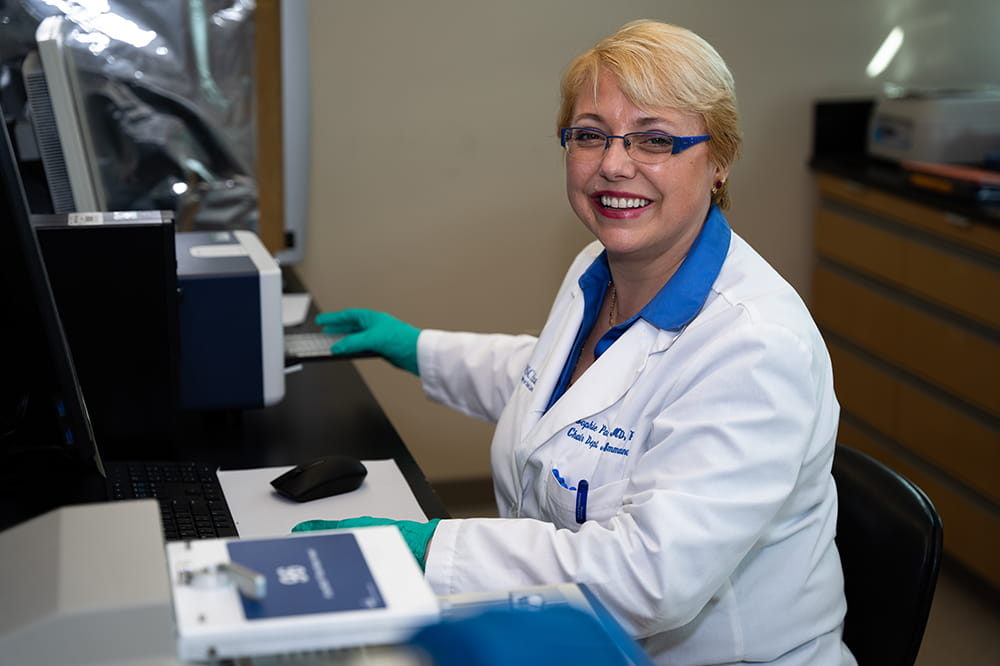
Related News
Hollings researcher Sophie Paczesny led a multicenter team to identify risk biomarkers of chronic graft-versus-host disease.

Researchers at MUSC Hollings Cancer Center have identified a signaling loop involved in the growth and persistence of leukemia cells – and developed a novel immunotherapy that can disrupt that loop to boost immune function and improve survival. The findings, published in Nature Communications, offer new hope for treating and preventing cancer.
Hollings researcher Sophie Paczesny, M.D., Ph.D., co-leader of the Cancer Biology and Immunology Research Program, led the multidisciplinary research team. Paczesny, a pediatric hematologist-oncologist and bone marrow transplant expert, has spent her career fighting one of the most difficult-to-treat blood cancers: acute myeloid leukemia (AML).
“I’ve seen too many patients – especially children – suffer from AML,” Paczesny said. “Unlike other forms of leukemia that respond well to chemotherapy or CAR-T cell therapy, AML has proven much more stubborn.”
AML is a fast-growing and aggressive form of blood cancer. Even with treatment, the cancer often comes back. This high rate of relapse can be traced to leukemia stem cells, a small group of cells that can survive chemotherapy by hiding in the bone marrow. These “hidden” cells then send out signals that both help the cancer grow and prevent the immune system from fighting back.
The new study revealed a key pathway used by these leukemia cells: the loop between a protein called IL-33 and its receptor IL1RL1.
“The more aggressive the leukemia, the more IL1RL1 we saw,” Paczesny said. “And, in AML, it forms a damaging feedback loop. The leukemia starts and keeps growing because of stress that triggers a self-sustaining loop between IL-33 and its receptor, which also creates an immune environment that helps the cancer avoid being attacked.”
To break the feedback loop, the researchers developed a novel immunotherapy using a lab-made antibody. Known as a bispecific antibody, the treatment worked via dual means:
“These leukemia cells have learned to create a protective environment that helps them grow and avoid treatment,” Paczesny said. “We developed a bispecific antibody that can break through that environment and target the cells directly.”
In lab and mouse models, this dual-targeting approach not only destroyed the cancer cells but also removed their protective immune bubbles, making it easier for the body to fight back. The antibody slowed or stopped leukemia cell growth, limited immune suppression and reduced relapse rates. Even in tough cases where leukemia had already taken hold, the new therapy improved survival. And it did so without causing major side effects.
This study showed that targeting the signaling pathway used by leukemia stem cells can lead to better care for cancer patients. The researchers created an immunotherapy that not only killed cancer cells but also disrupted the immune system’s ability to protect them. By blocking a hidden cancer signal, that therapeutic may one day stop leukemia in its tracks.
The promising results offer an approach that could improve treatments for AML as well as other cancers with a similar tumor microenvironment.
“IL1RL1 is expressed in other cancers too: colorectal, lung, ovarian, even brain cancers,” Paczesny said. “This could be a game-changer for many difficult-to-treat cancers.”
The researchers also see the new antibody as overcoming some of the challenges of existing treatments. For instance, its low toxicity could make it safer to use and more acceptable to patients. It is also easier and less expensive to produce.
“Chemotherapy is toxic, and bone marrow transplants can come with serious risks. With immunotherapies like CAR-T cells, you need a customized treatment for each patient, which is expensive and time-consuming,” Paczesny explained. “Our treatment is an off-the-shelf drug. And it targets cells just enough to fight cancer without destroying the whole system. This could mean less time in the hospital, fewer side effects and a better quality of life.”
More work is needed before the antibody can be used with patients, but this study is a major step forward. It could eventually lead to new treatments that target cancer cells at their roots and offer an option when standard treatments fail. The researchers are already working on next steps and are hopeful that Phase I clinical trials are on the horizon.

Related News
Hollings researcher Sophie Paczesny led a multicenter team to identify risk biomarkers of chronic graft-versus-host disease.

Related News
A Hollings researcher wants to ID risk biomarkers to enable doctors to stop a serious side effect of stem cell transplant before it happens.

Related News
Leukogene Therapeutics Inc. introduces a promising therapy to treat multiple cancers and hopes to become flagship entity for MUSC’s innovation ecosystem.

Music mogul Sean 'Diddy' Combs was acquitted of sex trafficking and racketeering charges but convicted on transportation...

Former Arsenal midfielder Thomas Partey has been formally charged with multiple counts of rape and sexual assault by UK ...

JAMB has clarified its admission policies, rectifying a student's status, reiterating the necessity of its Central Admis...

Ghana is undertaking a comprehensive economic overhaul with President John Dramani Mahama's 24-Hour Economy and Accelera...

The 2024 Women's Africa Cup of Nations opened with thrilling matches, seeing Nigeria's Super Falcons secure a dominant 3...

A new opposition coalition, led by the African Democratic Congress (ADC), is emerging to challenge President Bola Ahmed ...
Oba Owolabi Olakulehin, the 43rd Olubadan of Ibadanland, has died at 90, concluding a life of distinguished service in t...

Nigerian football mourns the death of legendary Super Eagles goalkeeper Peter Rufai, who passed away at 61. Known as 'Do...

An IMF study shows that countries delisted from high-risk financial jurisdiction lists often experience a surge in capit...

Explore the top 5 regulated crypto platforms in Japan. Trade safely with government-approved exchanges offering security...

Vietnam’s new crypto law aims to boost compliance and exit the FATF gray list. It seeks to restore investors’ trust and ...

Luno, the global cryptocurrency platform, has re-entered the Kenyan market after a decade, offering a full suite of trad...

In this episode of the TechTrends Podcast, we sit down with Edline E. Murungi, Senior Legal Counsel for East Africa at...